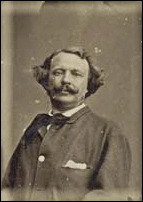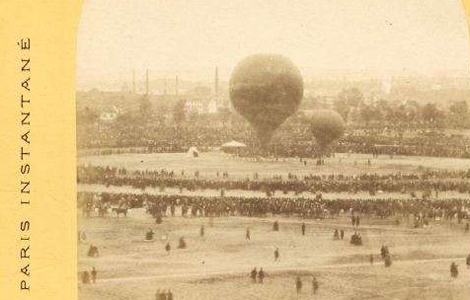Flight of the Giant
In 1863, the world’s first aerial photographer launched the world’s largest balloon. It didn’t go so well.
/https://tf-cmsv2-smithsonianmag-media.s3.amazonaws.com/filer/5a/63/5a63a606-a885-4681-a347-ffc20f443b0e/balloon-car-ghost.jpg)
In 1858, Félix Tournachon, better known by his professional name, “Nadar,” took a camera up in a tethered hot air balloon and became the first aerial photographer.
Five years later, he launched the world’s largest gas balloon, known as Le Géant (Giant). The 196-foot-tall balloon had required more than 300 seamstresses to assemble its 22,000 yards of silk, and at the time was the most elaborate aerial vehicle ever devised.
Donald Dale Jackson described Le Géant in his 1981 book The Aeronauts:
It was an airborne cottage. Made of wicker, two stories high with a balcony on its roof, it contained six compartments: two cabins, a printing room, a photographic office, a lavatory and a storeroom. The balloon made two ascents from Paris in October of 1863, attracting the largest crowds for any aeronautical event since the historic flight of Jacques Charles 80 years before. But it was just as well that the crowds were not around for the landings.
Nadar and his two deputies, the ballooning brothers Jules and Louis Godard, carried 12 eager passengers on Le Géant‘s much-publicized maiden voyage on October 4. By the time they lifted off, late in the afternoon, spectators had become so impatient with the tedious inflation process that they watched the ascent in petulant silence. Anticipating an all-night ride across Europe, the passengers had thoughtfully provided themselves with guidebooks and passports, but it was soon evident they would not need them: The balloon dropped violently to earth after only 15 miles, dragging the wicker bungalow on its side for a bone-rattling mile.
If the first flight was a disappointment, the second, a fortnight later, was a catastrophe. The audience for this ascent, estimated at half a million, included both the Emperor Napoleon III and the King of Greece. Again the lift-off was delayed, but this time the great balloon sailed gracefully off to the northeast, climbing easily to an altitude of 4,000 feet. The six passengers and three crewmen repaired to the balcony for a fine meal as the balloon floated toward Belgium, then over the Netherlands and into Germany. By dawn they had traveled some 400 miles. As they watched a brilliant sunrise, Nadar, fearing that the sun’s heat would cause the balloon to burst, ordered a descent.
Suddenly the idyll was transformed into a roller-coaster ride as the monster balloon encountered strong winds near the ground. They had valved gas so liberally on the way down that they were unable to reascend. Le Géant bounded across woods and fields, tearing through trees and bouncing off the earth, Nadar said, ‘like an India rubber ball from the hands of an indefatigable player.’ Nadar saw to his dismay that they were on a collision course with a railroad train. ‘A few more revolutions of the wheels and it will all be over,’ he wrote in a fervid memoir. ‘A single cry escapes our throats, but what a cry!’ The engineer whistled in reply and halted the train with feet to spare. Moments later the runaway balloon finally stopped at the edge of a wood, and burst. The passengers, most of whom had jumped or had been thrown from the car, were strewn over the ground like so many fallen apples.”
Le Géant made just five flights. But even after his grand experiment failed, Nadar remained interested in ballooning; during the 1870 Franco-Prussian War and the Paris Commune (the government that briefly ruled Paris in 1871), he provided, at his own expense, reconnaissance and postal balloons. These efforts bankrupted him, although he regained much of his wealth by 1885.

